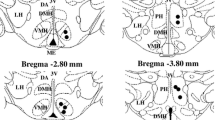Abstract
A stress-free, biotelemetric monitoring technique was used to investigate the effects of ambient temperature (T a) on the hyperthermic and hyperkinetic effects of 3,4-methylenedioxymethamphetamine. In the first experiment a single injection of 5.0 or 7.5 mg/kg MDMA produced hyperthermia in rats maintained at aT a of 24°C but hypothermia in rats maintained at aT a of 11°C for 24 h prior to the injection. In contrast, hyperkinesis was induced at bothT as. In the second experiment, the effects of acute MDMA administration was compared in rats maintained at a standardT a of 24°C and in rats which were placed in a cool (11°C) room for a brief (90-min) period commencing 30 min after the injection. The brief exposure to the cool environment produced significant attenuation of MDMA-induced hyperthermia but did not affect the magnitude of hyperkinesis. The implications of the results for the understanding of the thermotoxic effects of MDMA in human drug users are discussed.
Similar content being viewed by others
References
Cunningham CL, Peris J (1983) A microcomputer system for temperature biotelemetry. Behav Res Methods Instrum 6:598–603
Dafters RI, Taggart P (1990) Interaction of circadian rhythm and opiate-induced thermic and kinetic responses: a biotelemetric investigation. Life Sci 47:2155–2161
Dafters RI, Taggart P (1992) A biotelemetric investigation of morphine's thermic and kinetic effects. Psychopharmacology 106:195–201
Eikelboom R (1986) Learned anticipatory rise in body temperature due to handling. Physiol Behav 37:649–653
Gordon CJ, Watkinson WP, O'Callaghan JP, Miller DB (1991) Effects of 3,4-methylenedioxymethamphetamine on autonomic thermoregulatory responses of the rat. Pharmacol Biochem Behav 38:339–344
Henry JA, Jeffreys KJ, Dawling S (1992) Toxicity and deaths from 3,4-methylenedioxymethamphetamine (“ecstasy”). Lancet 340:384–387
Jacob JJ, Girault J-M (1979) 5-Hydroxytryptamine. In: Lomax P, Schonebaums (eds) Body temperature regulation, drug effects and therapeutic implications. Dekker, New York; pp 183–230
Johnson MP, Hoffman AJ, Nichols DE (1986) Effects of the enantiomers of MDA, MDMA and related analogues on [H3]dopamine release from superfused rat brain slices. Eur J Pharmacol 132:269–276
Myers RD (1980) Hypothalamic control of thermoregulation — neurochemical mechanisms. In: Morgane PJ, Panksepp J (eds) Handbook of the hypothalamus. Dekker, New York; pp 83–210
Nash JF, Meltzer HY, Gudelsky GA (1988) Elevation of serum prolactin and corticosterone concentrations in the rat after administration of 3,4-methylenedioxymethamphetamine. J Pharmacol Exp Ther 245:873–879
Peris J, Cunningham JL (1986) Handling-induced enhancement of ethanol's acute physiological effects. Life Sci 38:273–279
Robinson TE, Becker JB (1986) Enduring changes in brain and behavior produced by chronic amphetamine administration: a review and evaluation of animal models of amphetamine psychosis. Brain Res Rev 11:157–198
Schmidt CJ, Levin JA, Lovenberg W (1987) In vitro and in vivo neurochemical effects of methylenedioxymethamphetamine on striatal monoaminergic systems in the rat brain. Biochem Pharmacol 36:747–755
Screaton GR, Cairns HS, Sarner M, Singer M, Thrasher A, Cohen SL (1992) Hyperpyrexia and rhabdomyolysis after MDMA (“ecstasy”) abuse. Lancet 339:677–678
Spanos LJ, Yamamoto BK (1989) Aucte and subchronic effects of methylenedioxymethamphetamine [(±)MDMA] on locomotion and serotonin syndrome behavior in the rat. Pharmacol Biochem Behav 32:835–840
Tehan B (1993) Ecstasy and dantrolene. BMJ 306:146
Ugedo L, Grenhoff J, Svensson TH (1989) Ritanserin, a 5-HT2 receptor antagonist, activates midbrain dopamine neurons by blocking serotonergic inhibition. Psychopharmacology 98:45–50
Yamamoto BK, Spanos LJ (1988) The acute effects of methylenedioxymethamphetamine on dopamine release in the awakebehaving rat. Eur J Pharmacol 148:195–203
Yehuda S, Kahn M (1977)d-Amphetamine thermal effects, metabolic rate and motor activity in rats. Int J Neurosci 7:207–210
Author information
Authors and Affiliations
Rights and permissions
About this article
Cite this article
Dafters, R.I. Effect of ambient temperature on hyperthermia and hyperkinesis induced by 3,4-methylenedioxymethamphetamine (MDMA or “ecstasy”) in rats. Psychopharmacology 114, 505–508 (1994). https://doi.org/10.1007/BF02249342
Received:
Revised:
Issue Date:
DOI: https://doi.org/10.1007/BF02249342




